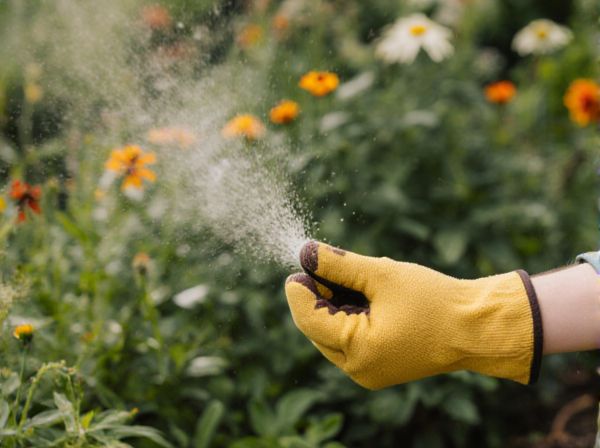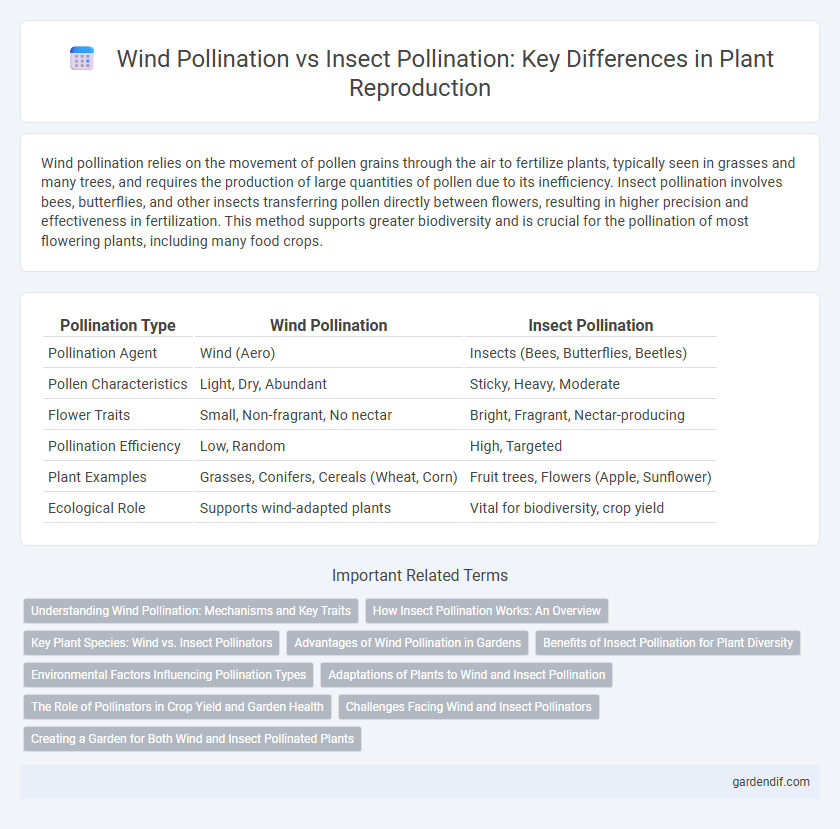
Wind Pollination vs Insect Pollination Illustration
Wind pollination relies on the movement of pollen grains through the air to fertilize plants, typically seen in grasses and many trees, and requires the production of large quantities of pollen due to its inefficiency. Insect pollination involves bees, butterflies, and other insects transferring pollen directly between flowers, resulting in higher precision and effectiveness in fertilization. This method supports greater biodiversity and is crucial for the pollination of most flowering plants, including many food crops.
Table of Comparison
| Pollination Type | Wind Pollination | Insect Pollination |
|---|---|---|
| Pollination Agent | Wind (Aero) | Insects (Bees, Butterflies, Beetles) |
| Pollen Characteristics | Light, Dry, Abundant | Sticky, Heavy, Moderate |
| Flower Traits | Small, Non-fragrant, No nectar | Bright, Fragrant, Nectar-producing |
| Pollination Efficiency | Low, Random | High, Targeted |
| Plant Examples | Grasses, Conifers, Cereals (Wheat, Corn) | Fruit trees, Flowers (Apple, Sunflower) |
| Ecological Role | Supports wind-adapted plants | Vital for biodiversity, crop yield |
Understanding Wind Pollination: Mechanisms and Key Traits
Wind pollination relies on lightweight, aerodynamic pollen grains that are produced in large quantities to increase the likelihood of reaching female reproductive structures. Plants adapted to wind pollination typically have long, feathery stigmas to capture airborne pollen and lack bright petals or nectar since they do not need to attract insect pollinators. Key traits include exposed stamens and stigmas, reduced floral parts, and high pollen output, enabling effective pollen dispersal through air currents rather than biotic vectors.
How Insect Pollination Works: An Overview
Insect pollination involves pollinators such as bees, butterflies, and beetles transferring pollen grains from the male anthers of a flower to the female stigma, facilitating fertilization. This process enhances genetic diversity and increases fruit production by enabling targeted pollen transport compared to the random dispersal seen in wind pollination. Flower traits like bright colors, nectar, and scent have evolved specifically to attract these insect pollinators, ensuring effective and efficient pollination.
Key Plant Species: Wind vs. Insect Pollinators
Wind pollination predominantly benefits grass species such as maize, wheat, and rye, where lightweight, abundant pollen grains are dispersed over long distances without the need for animal intermediaries. Insect pollination primarily supports flowering plants like apples, almonds, and blueberries, relying on bees, butterflies, and other insects to transfer sticky or spiky pollen directly between flowers. The efficiency of insect pollinators enhances genetic diversity and fruit yield, whereas wind pollination is advantageous for plants with large, exposed inflorescences adapted to open habitats.
Advantages of Wind Pollination in Gardens
Wind pollination offers several advantages in garden settings, including consistent pollen distribution regardless of insect population fluctuations, which enhances the fertilization rate of certain plants like grasses and trees. It requires less energy investment from plants in producing nectar or scent, allowing resources to be allocated to growth and seed production. Wind-pollinated plants are also less dependent on environmental conditions that affect insect activity, such as temperature and humidity, ensuring more reliable pollination.
Benefits of Insect Pollination for Plant Diversity
Insect pollination enhances plant diversity by enabling targeted pollen transfer between flowers, which promotes cross-pollination and genetic variation. Bees, butterflies, and other pollinators increase reproductive success in flowering plants, supporting ecosystem resilience. Unlike wind pollination, insect interactions facilitate the survival of specialized plant species with diverse floral traits.
Environmental Factors Influencing Pollination Types
Wind pollination thrives in open, dry, and windy environments where pollen can be easily carried over long distances, favoring plants like grasses and conifers. In contrast, insect pollination is more efficient in diverse ecosystems with abundant floral resources and moderate climates, attracting pollinators such as bees, butterflies, and beetles. Environmental factors like humidity, temperature, and habitat structure significantly influence the predominance of wind or insect pollination in a given area.
Adaptations of Plants to Wind and Insect Pollination
Plants adapted to wind pollination typically feature lightweight, abundant pollen and exposed stamens to maximize dispersal by air currents. Insect-pollinated plants often exhibit brightly colored petals, nectar production, and strong scents to attract specific pollinators. Structural modifications such as sticky or barbed pollen grains enhance adherence to insect bodies, facilitating efficient pollen transfer.
The Role of Pollinators in Crop Yield and Garden Health
Pollinators such as bees and butterflies significantly enhance crop yield by facilitating insect pollination, which increases fruit set and quality. Wind pollination, while effective in certain crops like cereals, generally results in lower genetic diversity and reduced garden ecosystem health. Encouraging diverse pollinator populations improves plant reproduction, boosts food production, and supports sustainable garden ecosystems.
Challenges Facing Wind and Insect Pollinators
Wind pollination faces challenges such as dependence on favorable wind patterns and the inefficiency of pollen transfer over long distances, leading to high pollen wastage. Insect pollinators encounter threats from habitat loss, pesticide exposure, and climate change, which disrupt foraging behavior and reduce population numbers. Both pollination methods are integral to ecosystem balance, yet their vulnerabilities necessitate conservation efforts to ensure plant reproduction and biodiversity.
Creating a Garden for Both Wind and Insect Pollinated Plants
Designing a garden that supports both wind and insect pollination requires selecting diverse plant species that cater to each pollination method. Incorporate dense clusters of grasses, sedges, and trees like oaks and pines for effective wind pollination, while adding brightly colored, fragrant flowers such as lavender, sunflowers, and milkweed to attract bees, butterflies, and other pollinators. Providing varied habitats with native plants and minimizing pesticide use enhances pollination efficiency and promotes a balanced ecosystem.
Wind Pollination vs Insect Pollination Infographic

 gardendif.com
gardendif.com